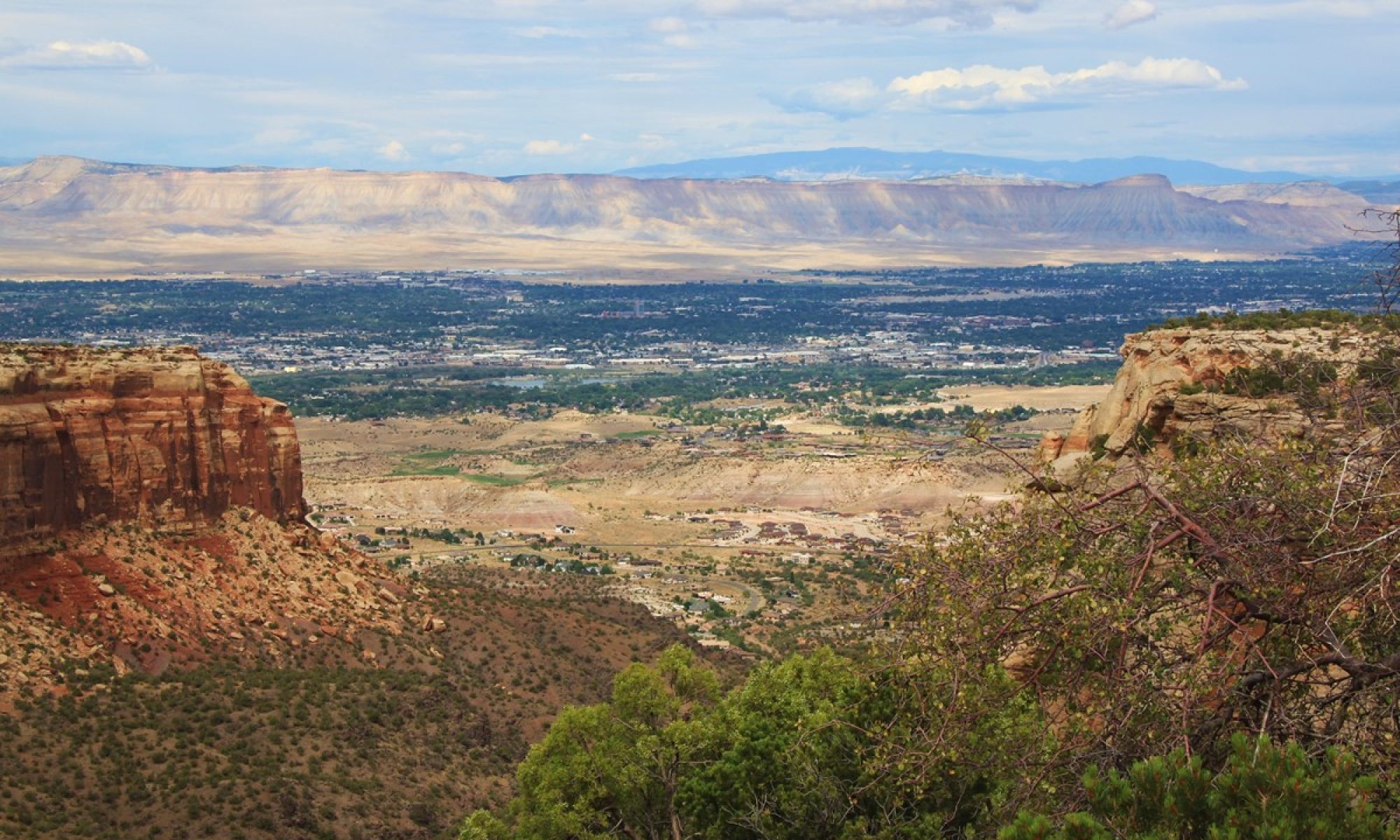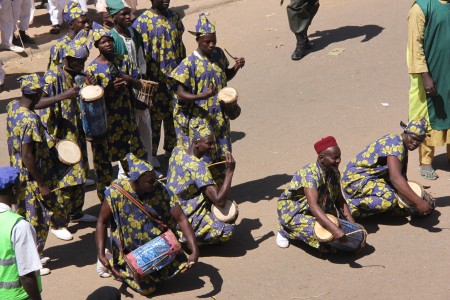November 4-9, 2011
In the northern reaches of Nigeria, near the southern entrance to the great Sahara desert, lies the ancient city of Kano. Kano lies within the state of the same name, and is bordered to the northwest by the state of Katsina. Kano was first settled in the 7th century by the Hausa people, is the oldest city in West Africa, today is the 2nd largest city in Nigeria, (populated by ~7 million people), and is predominantly Islamic.
Kano’s “old city” is surrounded by a massive 11th century mud and brick wall (sarlsi-gujmasu) which still stands tall in many areas, and must be navigated by a series of gates (“kofar”) that are now freely open.
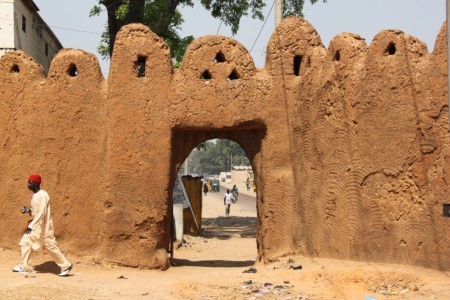
Our trip to the Nigerian north is to see the people and land there and to attend the Katsina and Kano Durbars. These multi-day Durbar Festivals date back hundreds of years to a time when the local Emirates (states) defended themselves and their Emir with a fierce military Calvary. The Calvary was made up of regiments from different nobility and local chiefs. During this time, once or twice a year, the many regiments would gather and parade for the Emir, colorfully demonstrating their horsemanship, bravery and loyalty.
Our trip has been organized by Paulette Van Trier, a Belgium National attached professionally and long term in Nigeria, previously in Kano, and now in Lagos. During her stay in the country, she has developed personal contacts in the Kano and Katsina region that allow her to organize this cultural trip for 42 people, as part of the Nigerian Field Society’s annual program.
Today, Durbars have become a festival welcoming dignitaries and heads of state, coinciding with the two great Muslim festivals, Eid-el Fitri and Eid-el Kabir. We are attending the festivals with Eid-el Kabir, which commemorates the Prophet Ibrahim sacrificing a ram instead of his son.
We start our adventure by flying on Friday evening from Lagos to Kano via Abuja on Air Nigeria. The runways at each airport all hold large jumbo jets this time of year: they are prepared to move people for the Hajj, their annual pilgrimage to Mecca. Our travel is smooth, as we are met at the airport by two large coaches and are shuttled a short distance to our base of stay – The Prince Hotel. The hotel is lush and beautiful with excellent service, as we grab a late snack and prepare for Saturday’s sightseeing and cultural tours.
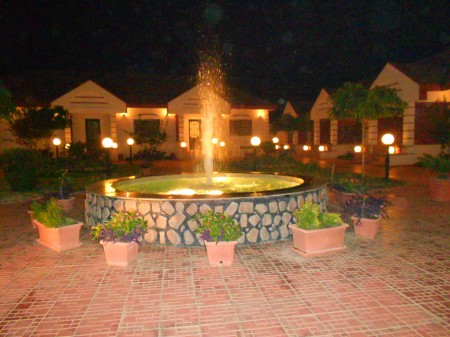
Our group is a diverse collection of Nigerians and Expats for all across the world. We include not only residents of Abuja, Port Harcourt and Lagos, but others who have flown in from London and the USA to participate in this trip. We also have a strong collection of industry and embassy staff representing various countries.
Saturday starts with a buffet breakfast poolside before we board our buses and meet our “guides”, Abu and Friday. Friday has been a guide for these groups for over 14 years. We are driven into the old city through one of the 14 gates that allow entrance through the 25 kilometer-long walled circumference. In the “old days” the cities gates were kept closed between 6pm and 8am and people would wait for their opening. However today, all gates are open all the time. It is clear that although Kano is an old city, it is clean and well maintained. The roads are in good shape as we make our way past the local Football Stadium (home of the Caterpillars) to a family “Dye Pit” operation located at the “Kofar Mata”, the “women’s gate”. This particular site has been used to dye cloth in the traditional ways for nearly 800 years. The pits are full of a “dye” which is made from indigo, potassium, ash, and water (~1500 liters water, 100 kilograms indigo, 40 buckets ash and 5 buckets potassium). The mixture is left in the pit for ~4 weeks where it “ferments” and causes the indigo to turn dark blue. The cloth is then hand-dipped in the pit and then held out over the pit to drip dry in the wind before repeating. This process ensures that the dye is adhered to the cloth. The process is repeated hundreds of times over 4-6 hours depending on the darkness of the color desired. In order to create designs on the materials, the cloth is banded, tied, bundled, etc. to create areas where the dye cannot permeate. The dye itself can be used in that pit for nearly 1 year, and then a new batch is needed to be mixed.
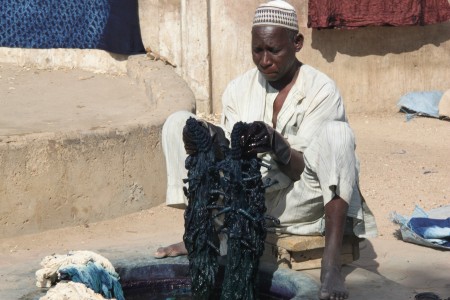
Once the cloth is dyed and dried, it is taken to the “pounding shed” where it can be made shinny by pounding the cloth between a smooth mahogany paddle and a long, smooth mahogany log. The impact on the material, coupled with the ash from the dye process, creates a beautiful sheen to the fabric.
Our next stop is the Gidan Makama National Museum. It is made up of 9 galleries through which we are guided in groups of 10. Gidan means “house” and this museum was originally the guest house of Makama who became King of the region in 1442, and used it as a temporary palace. The new palace, Gidan Rumfa, was built across the street and was completed in 1478 for King Rumfi and is the site of the Emir’s Palace today. Gidan Makama today operates in 3 sections: The Primary School, the Makama Guest House for the Emir’s guests, and the Museum with its 9 galleries.
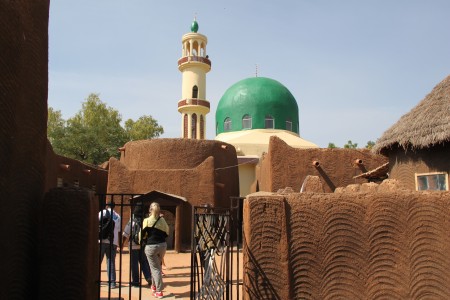
Mohammed Rumfi was King of Kano from 1463-1499. Kano was ruled by Hausa Kings from that point but suffered bloody internecine wars that saw the city finally fall to Fulani raiders during the jihad Othman Dan Fodio in 1803. In 1804, the 1st Emir was emplaced, and the ruling Fulani’s used the Durbar to demonstrate their strength and allegiance. Today, the Hausa or “common people” make up about 60% of the population with the Fulani accounting for the other 40%. In 1903, the British invaded and conquered Kano. The Gidan Makama Museum opened in 1985.
Next on the agenda was to actually visit the wall at one of the city gates. The wall is made of mud brick stacked and mud-plastered over, and is arranged 10-12 feet thick and 20-25 feet high.
From here we returned to the hotel for lunch, and prepare to shop in the afternoon at the five-hundred year-old Kurmi Market.
The afternoon market trip was very much like the typical “markets in Nigeria”. Rows of narrow corridors lined with vendors making and marketing nearly anything that one might think of. Everything is negotiable, but the items of interest to our group were principally fabric, blankets, beads and clothes. It was clear that the locals were also shopping today for the pending great holiday festival.
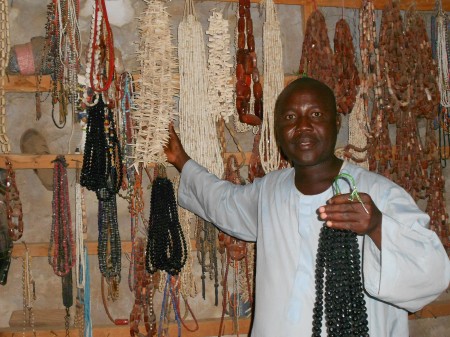
After the market, we relaxed with a Lebanese buffet dinner at the hotel by the pool.
Sunday morning we made an early start to travel by bus to Katsina, a city 170 kilometers to the northwest of Kano which historically served as a crossroads of trade on the trans-Sahara route from Timbuktu. The area around Katsina today is dominated by rolling hills, dry climate but quite a bit of agriculture using simple forms of irrigation. The region exports grains (wheat, sorghum, tomatoes, peppers & cotton) principally to Chad, and to southern Nigeria. The landscape is punctuated by the honored Bilibab tree, with which the locals have a symbiotic relationship. The land is littered by wadi scars and is covered elsewhere by small scrubs, grasses and the occasional tree that reminds one of typical East African landscapes. But, there are no “roaming” animals, and no wildlife is to be seen anywhere. Housing is principally built from the ever-present red clay bricks, and the landscape is dotted by granite boulders hills. Before we arrive in Katsina, we are surprised to see a massive modern ‘Windfarm” under construction, the first of 10 planned in Nigeria! However, we are informed later that the construction has been halted, the engineer is nowhere to be found, and that the engineering parts are disappearing over time. The State hopes to get work back underway in 2012.
The Katsina Durbar is a 3-day Festival where the first day is spent in prayer (Eid Durbar), the second in homage to the Emir (Hawan Daushe Durbar) and the third day as a “picnic” celebration where animals are slaughtered and food is shared (Hawan Nassarawa). We are here for day #2! Our buses make their way through the gates and onto the Palace grounds where we are escorted up to the covered reviewing stands, 2-3 levels high, into front row seats looking out over a large dirt parade field which is surrounded by throngs of people, vendors, and various security forces. Next to us are the Waziri of Katsina and his entourage and delegations from the embassies of Italy and Belgium, as well as the Governor of the State of Katsina.
The current Emir of Katsina is 53 years old and has been in office ~3 years. He has 4 wives and ~25 children. When it comes time to choose a new Emir, the “King Makers”, 4 trusted leaders, meet to choose someone of royal lineage, who is politically acceptable and meets their criteria. The Emir will be the last to enter the Festival procession.
The event begins with the Nigerian National Anthem, and the regiments of horse groups representing noble families and villages circle the grounds counter clockwise, passing to pay respect to the governor and viewing stands.
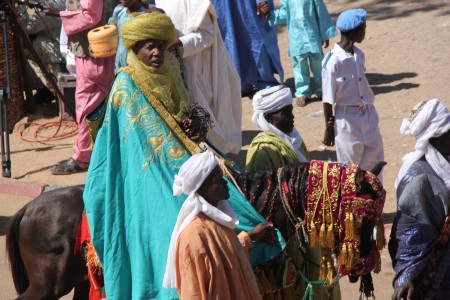
Once they have shown respect and the sign of “no weapon in my hand”, they proceed to line the sides of the Parade ground, until others join them.
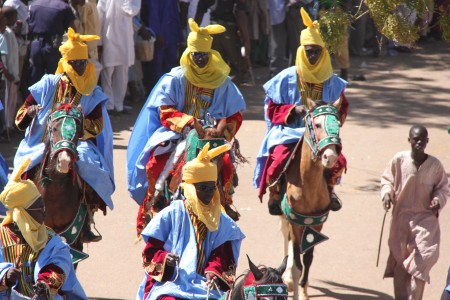
Groups are strictly only men, young and old, and include traditional drums and flutes, acrobats, and the spectacularly colorful costumes for riders and horses. Even the famous drummer Ettatisay parades in this event.
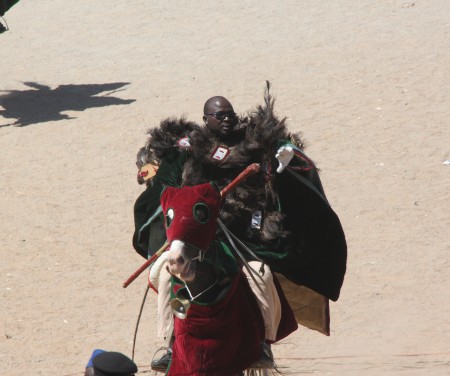
Finally, after ~ 70 minutes of precession and when ~2000 horsemen are assembled on the parade grounds, the Emir’s procession begins down the middle of the grounds, including his guards, riderless horses for his wives, and his sons. Finally, the Emir himself comes, easily identifiable by the huge umbrella which is pogo-ed, up and down, manually, over him. After he pays respect to the governor and the reviewing stand, the horse regiments sequentially mock-charge to him at a gallop to demonstrate their prowess. Finally, the Emir addresses the crowd who wildly approve. Then the Emir exits into the Palace, the riders disperse, the crowd mills about, and we exit the stands to visit the Emir in his Palace.
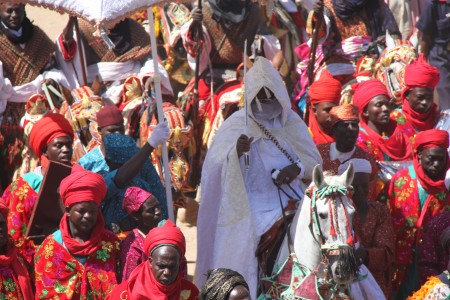
Initially we enter the palace through a walkway lined with cages of exotic birds. We are allowed to keep our shoes on as we enter a small sitting-welcome room where small-chop and drinks are served. Then, we are guided to one of the Emir’s small palace rooms (in fact, the trophy room) where the Emir, his Waziri and entourage enter. The Waziri welcomes us, as he tells us a little about the proud history of Katsina as a hub in the trans-Sahara trade route. He is clearly a very well educated man, passionate in his love of his city and of his Emir. At the end of his welcome, we are surprised when the Emir personally welcomes each of us with a handshake, before he moves on with his duties.
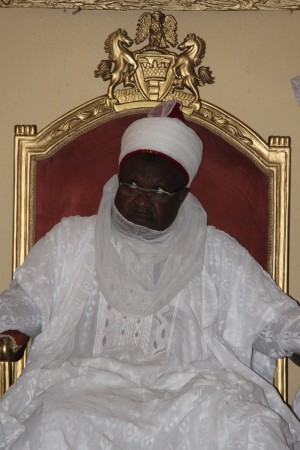
We exit the palace to our bus, where we transported a short distance to the local Liyafa Hotel to have lunch. After lunch, we enjoy the crystal blue skies and explore the local ground, remarking on the exotic “Calabash” tree, where calabash gourds over 1 foot in diameter hang from the branches like freakish giant tomatoes. Then, it’s back to the bus to make the long trip back to the Prince Hotel in Kano, and dinner at the Palace Chinese Restaurant. Later that evening after a long and busy day, about half of the group played iPod music and danced at the pool while the pool bar kept us supplied. For some, it wasn’t bedtime until after 1am.
